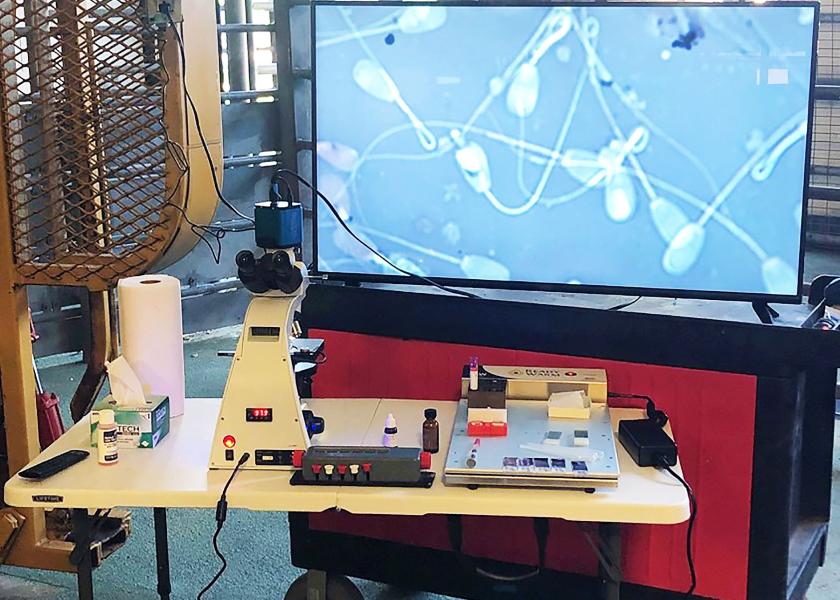BSEs help Veterinarians Provide a $7 ROI for every $1 Cow-Calf Producers Invest, on Average

As a bovine veterinarian, you have many irons in the fire at any given time during the year. That fact alone may cause you to second guess whether emphasizing breeding soundness exams (BSEs) before bull turnout this spring is worth your time and effort. The short answer to that question is, yes, they are, according to Chance Armstrong, DVM, MS, DACT, Auburn University College of Veterinary Medicine.
Armstrong likes to tell producers and veterinarians that BSEs are vital to conduct 30 to 60 days ahead of turnout for every bull, every year.
“It’s one of the best insurance policies your beef producers can have,” he says. “It helps them and you know their bull will get the job done and done well.”
A Snapshot In Time
Illness, effects from a harsh winter, inadequate nutrition and a variety of other factors can render a great bull from last season subfertile this spring. Or, you could simply be dealing with a young bull that needs more time to mature.
“I am an equal opportunity evaluator of bulls,” Armstrong says. “I evaluate them the same way every time so human elements don’t come into play if they fail. As veterinarians, that consistency is important to maintain.”
A consistent BSE strategy will help you do the best job of identifying subfertile bulls, according to Jennifer H. Koziol, DVM, MS, DACT, Texas Tech University School of Veterinary Medicine.
“We need to identify those subfertile bulls, because they can really hurt the producer’s bottom line,” Koziol says.
“With a subfertile bull what happens is the cow’s cycling, and the bull should have got her pregnant but missed her,” Armstrong adds. “Research shows us we can lose 50 to 60 pounds of weaning weight per 21-day cycle. We simply can’t afford that inefficiency in the beef industry.”
Show And Tell
For a bull to be deemed a “satisfactory potential breeder,” the Society for Theriogenology maintains that 70% morphologically normal sperm is the standard. Along with that, the bull must have a minimum of 30% progressively motile cells.
“Multiple studies have shown us that about 80% of the bulls that fail breeding soundness exams do so because of poor sperm morphology,” says Koziol.
Armstrong adds that beef producers benefit from knowing the quality of their bull’s sperm. Factors like nuclear vacuoles and pyriform heads can quickly impact fertility of the ejaculate.
“Information on the morphology is an important point of differentiation between you, the veterinarian, and what a layman is able to tell the producer,” Armstrong says. “We need to use that information to our advantage and to educate our producers.”
A good electroejaculator and a high-quality microscope can help the process along. While a phase-contrast microscope can make it easier to see certain sperm morphology defects, Koziol says a good brightfield microscope can get the job done just as well.
“Diadem defects (a sperm morphology abnormality) are a great way to know if your microscope is good enough or not,” she says. “If you can easily see diadem defects and recognize them on sperm morphology slides, then your microscope is good. If you never see them during an entire bull-checking season, then perhaps you should think about investing in a new microscope.”
In addition, Koziol says camera systems for microscopes have become more economical and can transmit the microscope image to a TV screen or monitor.
“This is a great way to add value to our examinations, as it takes the mystery away from what we are seeing in the microscope,” she says, noting that bull owners can quickly learn what normal and grossly abnormal look like.
“In my experience, owners who have observed the results will often call a bull unsatisfactory, even before I can finish counting 100 cells,” she says. “It makes my life easier when I can show an owner why their bull is not going to cut the mustard this breeding season.”
No Short Cuts To Excellence
Armstrong says a complete physical exam helps provide certainty that you have done due diligence for the bull and the producer.
The four key aspects of a complete breeding soundness exam are:
1. Physical Examination
2. Measuring Scrotal Size
3. Evaluation of Semen Morphology
4. Evaluation of Semen Motility
“When a bull passes all four parts of the exam, he is set up for reproductive excellence, meaning he should achieve a 60% to 65% conception rate every 21 days on those cycling cows that are healthy,” Armstrong says. “At the end of three cycles, the bull can have 90% to 95% of those cows bred, with most of them delivering in the front end of the calving season.”
“We actually make the operation money with the BSEs,” he adds. “The research shows us producers get about $7 for every $1 they invest in the process, and that’s a great return-on-investment.”
Society For Theriogenology Manual Updates
The Society for Theriogenology updated its recommendations regarding BSEs in 2018. Three of the Breeding Soundness Examination of Bulls manual changes are:
- With respect to morphology, the abaxial tail implantation and the distal droplet are no longer to be categorized as abnormalities.
- Also, the classification scheme designating sperm morphology abnormalities as Primary or Secondary was discontinued and descriptors with respect to location (head, midpiece, and tail) are currently utilized.
- With respect to motility, assessment should be by evaluation of progressive motility; the minimum standard (30% progressively motile) however was not changed.







